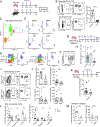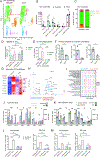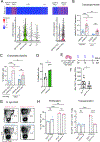Long-term tolerance to skin commensals is established neonatally through a specialized dendritic cell subgroup
- PMID: 37028427
- PMCID: PMC10330031
- DOI: 10.1016/j.immuni.2023.03.008
Long-term tolerance to skin commensals is established neonatally through a specialized dendritic cell subgroup
Abstract
Early-life establishment of tolerance to commensal bacteria at barrier surfaces carries enduring implications for immune health but remains poorly understood. Here, we showed that tolerance in skin was controlled by microbial interaction with a specialized subset of antigen-presenting cells. More particularly, CD301b+ type 2 conventional dendritic cells (DCs) in neonatal skin were specifically capable of uptake and presentation of commensal antigens for the generation of regulatory T (Treg) cells. CD301b+ DC2 were enriched for phagocytosis and maturation programs, while also expressing tolerogenic markers. In both human and murine skin, these signatures were reinforced by microbial uptake. In contrast to their adult counterparts or other early-life DC subsets, neonatal CD301b+ DC2 highly expressed the retinoic-acid-producing enzyme, RALDH2, the deletion of which limited commensal-specific Treg cell generation. Thus, synergistic interactions between bacteria and a specialized DC subset critically support early-life tolerance at the cutaneous interface.
Keywords: Staphylococcus epidermidis; commensal bacteria; commensals; dendritic cells; early-life immunity; neonatal immunity; regulatory T cells; retinoic acid; skin; tolerance.
Copyright © 2023 Elsevier Inc. All rights reserved.
Conflict of interest statement
Declaration of interests T.C.S. is on the Scientific Advisory Board of Concerto Biosciences. N.A. is on the Scientific Advisory Board for Shennon Biotech, and consults or lectures for 23andMe, Cellino Biotech, Janssen Pharmaceuticals, and Immunitas Therapeutics.
Figures







References
Publication types
MeSH terms
Substances
Grants and funding
LinkOut - more resources
Full Text Sources
Medical
Molecular Biology Databases

